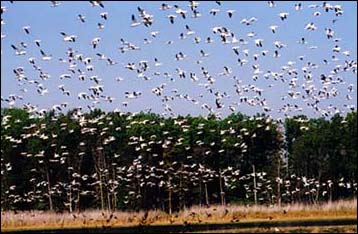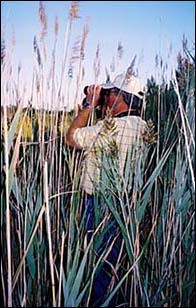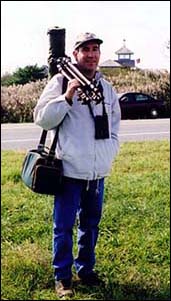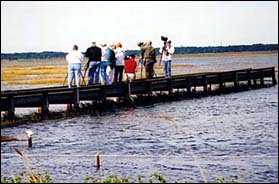Saturday, October 5:
Most of us arrived at our hotels in Dover, DE late on Friday evening, enjoyed a late dinner, and went to bed early, anticipating our first day of this first ever Delaware/New Jersey trip of the Three Rivers Birding Club.
 After an adequate continental breakfast at the Comfort Suites in Dover, most of the group headed out early for Bombay Hook National Wildlife Refuge. We stopped in the farm fields along Route 9 just outside Leipsic to investigate some birds spotted in the freshly plowed fields.
The birds included the first of many Black-bellied Plovers to be seen on this trip,
along with the trips only Horned Larks.
Flyovers included Caspian Terns,
Double-crested Cormorants,
Laughing Gulls,
and lots of Snow Geese.
Some distant Snow Geese in the fields turned out to be decoys. As we watched, a flock of Snow Geese flew in to the decoy flock. Shots rang out and at least one goose fell.
After an adequate continental breakfast at the Comfort Suites in Dover, most of the group headed out early for Bombay Hook National Wildlife Refuge. We stopped in the farm fields along Route 9 just outside Leipsic to investigate some birds spotted in the freshly plowed fields.
The birds included the first of many Black-bellied Plovers to be seen on this trip,
along with the trips only Horned Larks.
Flyovers included Caspian Terns,
Double-crested Cormorants,
Laughing Gulls,
and lots of Snow Geese.
Some distant Snow Geese in the fields turned out to be decoys. As we watched, a flock of Snow Geese flew in to the decoy flock. Shots rang out and at least one goose fell.
We were still early for meeting the rest of the group, so we started the car loop and stopped at Raymond Pool, where there were thousands of Snow Geese and shorebirds. We soon had identified hundreds of Dunlin, 400-500 American Avocet, Short-billed Dowitchers, Least and Semipalmated Sandpipers, and both species of yellowlegs. While the group continued to watch Raymond Pool, Jim drove back to the headquarters building to pick up the others. The entire group of 16 birders now included Jim Valimont, Mike Fialkovich, Bob Machesney, Mike Leahy, Paul Hess, Sam Sinderson, Linda Sporrer, Mary Stefanacci, Pat and Sherron Lynch, Randi and Sarah Gerrish, Janet and Warren Marvin, Julia Pahountis-Opacic, and a friend of Linda's from Wilmington, DE.
Shorebird study was frequently interrupted by the stoops of Peregrine Falcons, which we saw multiple times this day.
 As a flock of several hundred Dunlin
flew by to avoid a Peregrine Falcon,
they parted in the middle as they passed on either side of our group, and we could hear the rush of their wings as they flew past.
Careful examination of the massive flocks of the Snow Geese
revealed a Ross's Goose
that was debated as a hybrid for a while. When we finally decided it was indeed a Ross's Goose, we found another just ten feet away!
Moving on to other pools, Northern Pintail was the dominant duck,
but we also located both Green-winged
and Blue-winged Teal,
American Black Duck,
Wood Duck,
American Wigeon,
and Northern Shoveler.
Ospreys,
Bald Eagles,
Northern Harrier,
and Red-tailed Hawks were seen in various locations.
Boat-tailed Grackles,
Caspian Terns,
Swamp
and Savannah Sparrows,
Great Egrets,
Snowy Egrets,
Little Blue Herons,
and a Black-crowned Night-Heron at the end of
Bear Swamp Pool added variety to the morning's sightings.
As a flock of several hundred Dunlin
flew by to avoid a Peregrine Falcon,
they parted in the middle as they passed on either side of our group, and we could hear the rush of their wings as they flew past.
Careful examination of the massive flocks of the Snow Geese
revealed a Ross's Goose
that was debated as a hybrid for a while. When we finally decided it was indeed a Ross's Goose, we found another just ten feet away!
Moving on to other pools, Northern Pintail was the dominant duck,
but we also located both Green-winged
and Blue-winged Teal,
American Black Duck,
Wood Duck,
American Wigeon,
and Northern Shoveler.
Ospreys,
Bald Eagles,
Northern Harrier,
and Red-tailed Hawks were seen in various locations.
Boat-tailed Grackles,
Caspian Terns,
Swamp
and Savannah Sparrows,
Great Egrets,
Snowy Egrets,
Little Blue Herons,
and a Black-crowned Night-Heron at the end of
Bear Swamp Pool added variety to the morning's sightings.
We broke for lunch in Leipsic and returned to the refuge as the tide went out, exposing vast mudflats in the salt marsh. The heat really got to us in the afternoon, but good birds spurred us on. We soon added more shorebirds, including Willet, Semipalmated Plover, White-rumped Sandpiper, and Lesser Golden Plover. A single injured Ruddy Duck floundered in the mud, struggling to make it to cover. We also located a very strange Greater Yellowlegs, with a long down-turned bill! We checked several different field guides before concluding that we just had an aberrant Greater Yellowlegs.
If you have never seen it before, there is nothing that can prepare you for the sight and sound of thousands of Snow Geese taking off, flying overhead, or descending into the pools!



 We got an early start, drove to
We got an early start, drove to  Mike Fialkovich demonstrated how the snake flattens out its neck like a cobra to intimidate enemies. We left the snake to continue on its way as we reentered the pine woods.
We soon spotted a flock of feeding warblers that included several male
Mike Fialkovich demonstrated how the snake flattens out its neck like a cobra to intimidate enemies. We left the snake to continue on its way as we reentered the pine woods.
We soon spotted a flock of feeding warblers that included several male
 Time was short, so we drove to the ferry dock, where we added
Time was short, so we drove to the ferry dock, where we added
 We stopped at the
We stopped at the  After an early morning breakfast at the Captain's Cove Restaurant in Cape May (about the only place open at 6:00 AM),
we headed to
After an early morning breakfast at the Captain's Cove Restaurant in Cape May (about the only place open at 6:00 AM),
we headed to  With all of our scopes and all of theirs, we made sure that
everyone present got to look at the bird as long as he wanted.
First to arrive from the cell phone network was an English
birder, who commented to Mike, " Nice find, Mate!"
Other birders came running out with scopes and camera equipment
as the minutes passed. But the tide was now going out and
the bird was getting more difficult to observe. Within 15
minutes, the bird disappeared into the grass, disappointing
newly arrived birders. It was observed flying out into the
salt marsh later by Paul Lehman (former editor of Birding).
As far as we know, that was the last time that this bird was seen by anybody.
With all of our scopes and all of theirs, we made sure that
everyone present got to look at the bird as long as he wanted.
First to arrive from the cell phone network was an English
birder, who commented to Mike, " Nice find, Mate!"
Other birders came running out with scopes and camera equipment
as the minutes passed. But the tide was now going out and
the bird was getting more difficult to observe. Within 15
minutes, the bird disappeared into the grass, disappointing
newly arrived birders. It was observed flying out into the
salt marsh later by Paul Lehman (former editor of Birding).
As far as we know, that was the last time that this bird was seen by anybody.  From Nummy Island, we drove through Wildwood and stopped along Ocean Drive to view the marshes of the
From Nummy Island, we drove through Wildwood and stopped along Ocean Drive to view the marshes of the 

